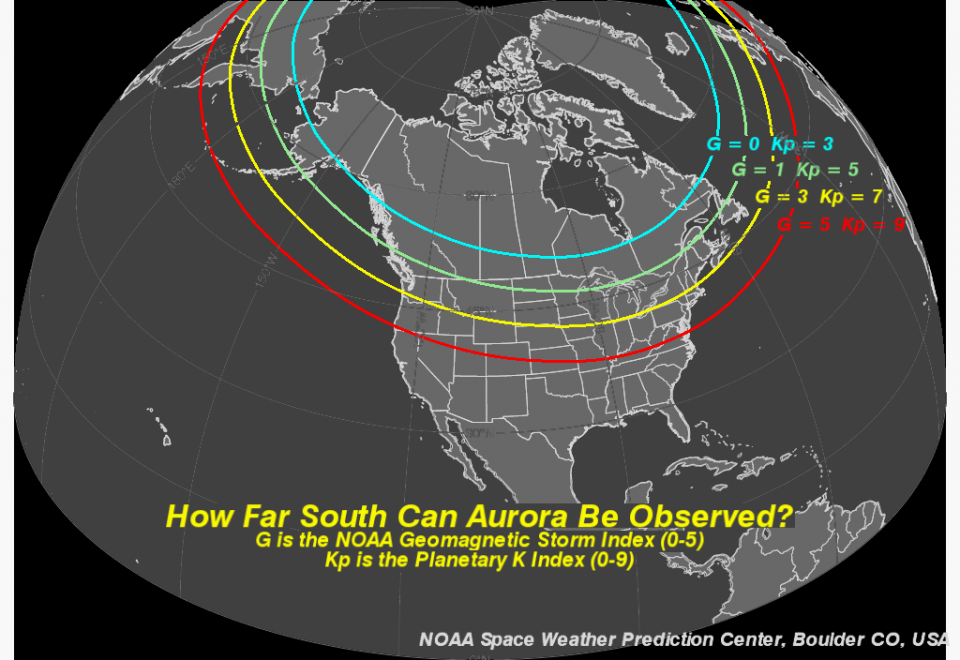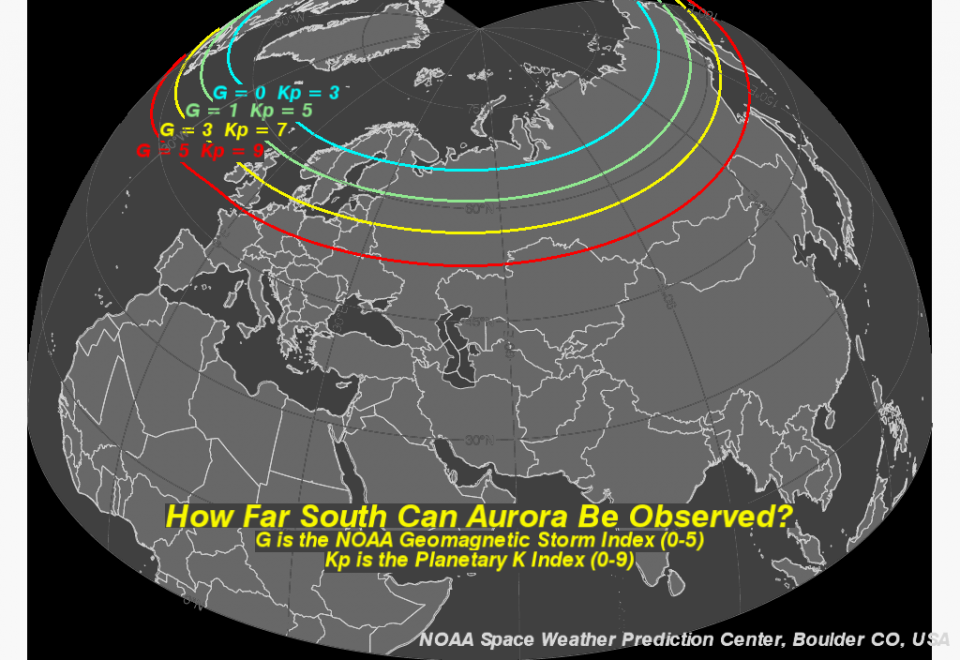Tips on Viewing Aurora:
Viewing the aurora depends on four important factors
- Geomagnetic Activity: If the geomagnetic field is active, then the aurora will be brighter and further from the poles. Geomagnetic activity is driven by solar activity and solar coronal holes and thus it waxes and wanes with time. The level of geomagnetic activity is indicated by the planetary K index or Kp. The Kp index ranges from 0 to 9.
- For Kp in the range 0 to 2, the aurora will be far north, quite dim in intensity, and not very active.
- For Kp in the range of 3 to 5, the aurora will move further from the poles, it will become brighter and there will be more auroral activity (motion and formations). If you are in the right place, these aurora can be quite pleasing to look at.
- For Kp in the range 6 to 7, the aurora will move even further from the poles and will become quite bright and active. At this geomagnetic activity level, it might be possible to see the aurora from the northern edge of the United States.
- For Kp in the range 8 to 9, the aurora will move even further towards the equator and it will become very bright and very active. These are the events that create the best aurora and the extended auroral oval will be observable by the most people. At these levels, aurora may be seen directly overhead from the northern states of the USA.
It should be noted that the relationship between Kp and auroral latitude are approximate and represent averages. There will be times when these relationships do not hold up exactly.
There is an approximate relationship between Kp and the equatorward extent of the auroral oval. This relationship holds true in geomagnetic latitude, not geographic. At Kp = 0, the equator ward edge of the auroral oval is approximately 66 degrees. And it moves equatorward about 2 degrees for each level of Kp. So for Kp = 1, the aurora would move down to 64 degrees, for Kp=2, it would move to 62 degrees, etc… until reaching Kp of 9 at 48 degrees magnetic latitude.
- Location: Go towards the magnetic poles. The north magnetic pole is currently about 400 km (250 miles) from the geographic pole and is located in the islands of north east Canada. Find a place where you can see to the north ( or south if you are in the southern hemisphere). Given the right vantage point, say for example on top of a hill in the northern hemisphere with an unobstructed view toward the north, a person can see aurora even when it is 1000 km (600 miles) further north. It should be noted that if you are in the right place under the aurora, you can see very nice auroral displays even with low geomagnetic activity (Kp = 3 or 4).
- It must be dark: Go out at night. Get away from city lights. The full moon will also diminish the apparent brightness of the aurora (not the actual brightness). One caveat that people often neglect to think of is that the high latitudes where aurora occur are also latitudes where it doesn’t get dark in the summer. So combining a summer vacation to the arctic with aurora watching usually doesn’t work. The aurora may still be there but it is only visible when it is dark.
- Timing: Best aurora is usually within an hour or two of midnight (between 10 PM and 2 AM local time). These hours of active aurora expand towards evening and morning as the level of geomagnetic activity increases. There may be aurora in the evening and morning but it is usually not as active and therefore, not as visually appealing.
The best Seasons for aurora watching are around the spring and fall equinoxes. Due to subtleties in the way the solar wind interacts with Earth’s magnetosphere, there is a tendency towards larger geomagnetic storms, and thus better auroras, to occur near the equinoxes. However, the number of hours of darkness decreases (increases) rapidly near the spring (fall) equinox so this caveat must be considered for those traveling to see the aurora.
Below are maps showing the most southern extent of where aurora might be observable for different levels of the geomagnetic Kp index (and the NOAA G scale). It should be noted that the aurora can often be observed hundreds of kilometers (miles) equatorward of the actual aurora so these figures do not indicate where the aurora may be but rather the point from which it may be observed.
Additional Resources:


